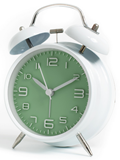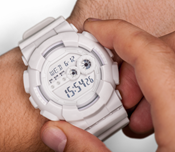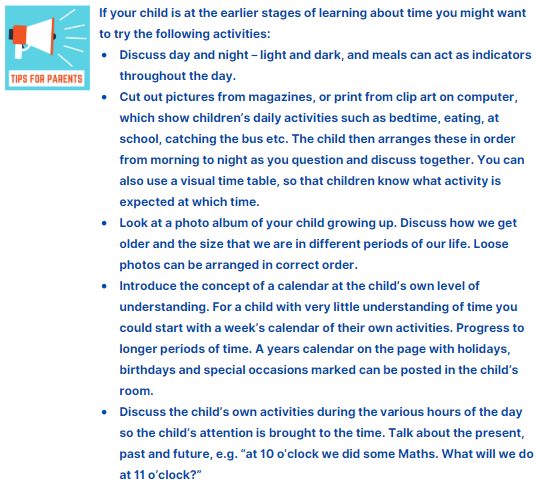 Learning about time and being able to tell roughly how long you have been doing a task can help you to manage your time. This can be hard. When you are learning about time you start by understanding night and day, the meaning of yesterday, today, tomorrow and the days of the week in order. You then develop a concept of hours and minutes and then learn about seconds. Understanding time can help your awareness of how long it takes to complete an activity and can help you to complete tasks within a certain time. Here are some activities to help you to develop your awareness of time:
Learning about time and being able to tell roughly how long you have been doing a task can help you to manage your time. This can be hard. When you are learning about time you start by understanding night and day, the meaning of yesterday, today, tomorrow and the days of the week in order. You then develop a concept of hours and minutes and then learn about seconds. Understanding time can help your awareness of how long it takes to complete an activity and can help you to complete tasks within a certain time. Here are some activities to help you to develop your awareness of time:
Understanding a minute:
Understanding a second:



Do you have a set morning, after school and or bedtime routine? Having a routine can save you time. Think about what you need to do in the morning before school to get to school on time.
Click here for a downloadable copy of the Morning Checklist.
Morning Routine Time Activity
 You can complete the activity in the presentation using the resource sheets here. Work with your parent or carer. Download both sheets How Long it Takes Me To (Young Person Version) and How Long it Takes My Child To (Adult Version). Think about how long it takes you to complete morning tasks and then time yourself. Did you guess right or do you need to allow for more time in the morning?
You can complete the activity in the presentation using the resource sheets here. Work with your parent or carer. Download both sheets How Long it Takes Me To (Young Person Version) and How Long it Takes My Child To (Adult Version). Think about how long it takes you to complete morning tasks and then time yourself. Did you guess right or do you need to allow for more time in the morning?
Morning Routine Assistance Activity
 Complete this activity with your parent or carer. Download both sheets What I do for myself / What I get help with (Young Person Version) and What my child does for themselves / What I help with (Adult Version). Once you have both completed your lists compare these. How much do you do for yourself and how much do you get help with? Could you be doing more for yourself?
Complete this activity with your parent or carer. Download both sheets What I do for myself / What I get help with (Young Person Version) and What my child does for themselves / What I help with (Adult Version). Once you have both completed your lists compare these. How much do you do for yourself and how much do you get help with? Could you be doing more for yourself?
 Now that you have planned your morning, now try the same for your after school and bedtime routine. You should try to be as organised as possible for the next day before you go to bed. This will save you time in the morning.
Now that you have planned your morning, now try the same for your after school and bedtime routine. You should try to be as organised as possible for the next day before you go to bed. This will save you time in the morning.
After School Routine
Bedtime Routine
Click here for a downloadable copy of the After School Checklist.
Click here for a downloadable copy of the Bedtime Checklist.
Check out the Creating a Routine section here for more advice about building a routine.
 Unless you have an exceptional memory, you will need something to remind you of the jobs you have to do every day.
Unless you have an exceptional memory, you will need something to remind you of the jobs you have to do every day.
At secondary school you will have a lot of different subjects to study, and more equipment to take with you each day. A ‘to do’ list or visual planner might help with this.
 Most people rely on lists, notes, or diaries to remind them of what needs to be done and when it has to be completed. You will have to use your diary/ planner in school to record which homework you have and when it has to be handed in.
Most people rely on lists, notes, or diaries to remind them of what needs to be done and when it has to be completed. You will have to use your diary/ planner in school to record which homework you have and when it has to be handed in.
Everyone has different ways of working and no single way suits everyone. We have put together some ideas of visual planners and lists which you may find helpful. Some people prefer a written ‘To do’ list, others may prefer to put up photographs or pictures. You might prefer to use your phone and there are apps that you can use to help.
See some examples of daily planners and weekly planners.
You may already have your new school timetable. It is very important that you check your timetable as it will tell you things such as:
 You will need to change classrooms throughout the day and you need to get to each lesson on time. If you don’t have a watch, it would be a good idea to buy one. If you buy one with an alarm it can remind you of any important times throughout the day. It can also wake you up in the morning!!! You could also use the clock and alarm on your phone if you have one.
You will need to change classrooms throughout the day and you need to get to each lesson on time. If you don’t have a watch, it would be a good idea to buy one. If you buy one with an alarm it can remind you of any important times throughout the day. It can also wake you up in the morning!!! You could also use the clock and alarm on your phone if you have one.
Timetable Activity Complete this activity with a friend or family member. Using a copy of the black/white timetable friend / family member to ask young person to find a subject. Now try same with a copy of the coloured timetable. Which timetable was easier? Could this help assist with organisation?
Complete this activity with a friend or family member. Using a copy of the black/white timetable friend / family member to ask young person to find a subject. Now try same with a copy of the coloured timetable. Which timetable was easier? Could this help assist with organisation?